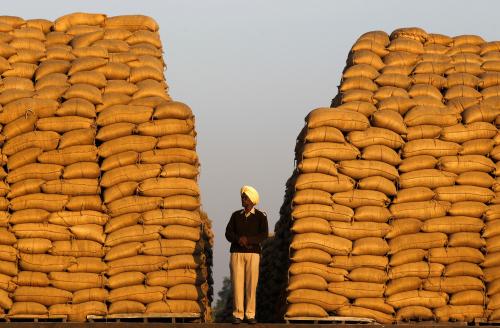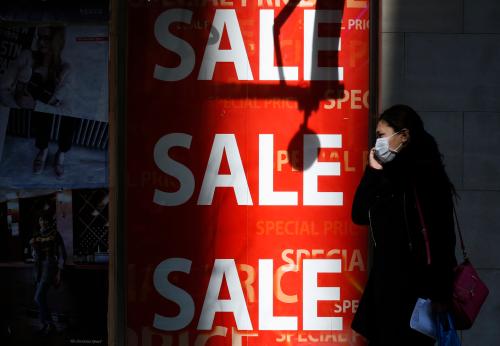Inflation has defied expectations everywhere. Half of all inflation-targeting central banks in developing economies now face inflation rates above their target range. Economic growth is slowing in low- and middle-income economies. And a cycle of monetary-policy tightening has begun that already is unlike any in recent memory. A month from now, the U.S. central bank is expected to raise interest rates, and investors are bracing for a big increase—the largest in more than 20 years.
That prospect poses dangers for developing economies. U.S. policy rates—particularly the size of the changes and the degree to which they surprise markets—tend to be a reliable predictor of crises in developing economies. Currency, banking, and debt crises usually have important domestic causes here. Nevertheless, since the 1970s they have been much more likely to occur when the Federal Reserve is in the process of raising interest rates (Figure 1).
 Historically, developing economies with ample monetary and fiscal policy space—along with healthy current-account balances, anchored inflation, and strong recovery prospects—have been able to withstand rate increases in advanced economies. Today, however, COVID-19 has depleted those defenses for a large number of developing economies. Investors have taken note: Capital flows to emerging markets dropped sharply between December and January, and many countries have already begun to experience capital outflows.
Historically, developing economies with ample monetary and fiscal policy space—along with healthy current-account balances, anchored inflation, and strong recovery prospects—have been able to withstand rate increases in advanced economies. Today, however, COVID-19 has depleted those defenses for a large number of developing economies. Investors have taken note: Capital flows to emerging markets dropped sharply between December and January, and many countries have already begun to experience capital outflows.
Developing economies still have time to protect themselves: For all the drama in markets lately, financial conditions remain relatively favorable for them. Yields on the 10-year U.S. Treasury bills—the most important indicator—have surged over the past few months but remain well below levels that preceded the global financial crisis in 2009. The same is true for 10-year German bunds. Policymakers would be wise to use the opportunity to put in defensive measures as quickly as possible. Specifically:
- Take preemptive action. All developing economies should identify and address vulnerabilities and put a crisis-response framework in place. They can also take immediate steps to beef up their fiscal resources—by eliminating inefficient expenditures and transfers, for example.
- Strengthen central bank independence. Bolstering legislation and procedures for monetary policy and bank supervision will help raise the credibility of macro frameworks and reduce the cost of policies to reduce inflation and maintain currency stability.
- Stress-test banks and prepare for restructuring. It’s crucial to know whether domestic banks will be able to withstand interest-rate increases in advanced economies. Countries that are especially vulnerable should establish precautionary credit lines, along with cash and foreign-exchange buffers. They should also build the information and expertise they will need for inevitable bank restructurings.
- Plan an orderly exit from the pandemic. It will matter a great deal how smoothly financial institutions unwind the forbearance measures—moratoriums on foreclosures and debt-service suspensions, for example—put in place during the pandemic. Stress-testing different scenarios could help policymakers identify where the temporary extension of such measures might make the most sense.
These measures should be calibrated, of course. Some countries face high financial and economic risks, the result of high debt and refinancing risks, slowing growth, and limited fiscal and monetary policy space. They should start with preemptive measures: Among other things, establish a crisis-response committee, reduce rollover risks by conducting liability-management exercises, and prearrange precautionary credit lines.
Other countries face mainly economic risks, owing in part to a combination of high debt and a close link between the local currency and the U.S. dollar. They, among other things, should bolster their currency-management tools so they can lower foreign-exchange volatility. In the medium term, they should also move to reduce debt and alleviate structural fiscal deficits.
A third set of countries faces mainly financial risks resulting from an abrupt change in investors’ appetite for risk. Such a shift reduces flows of foreign capital and diminish liquidity in local financial markets. For them, ensuring financial-sector liquidity and stability should be high on the agenda. They should also take steps to reduce their reliance on foreign portfolio flows while strengthening domestic insolvency frameworks.
Finally, some countries are in a relatively fortunate position: They are at low risk, mainly because they are not active borrowers in international markets and do not have much debt that needs to be refinanced. This includes many low-income countries. For these countries, the main task will be to maintain liquidity in the banking sector. Increasing local bond issuance can help.
The world is coming off an extraordinary era of success in monetary policy—a time when inflation dropped to exceptional lows, along with interest rates, in most parts of the world, a time when economic growth yielded shared prosperity to a degree rarely seen in the past. It’s not preordained that the shift to a more conventional policy environment of higher inflation and positive real interest rates must result in crisis.
But the time to act—to prevent a preventable crisis—is now.







Commentary
Developing economies face a rough ride as global interest rates rise
February 28, 2022